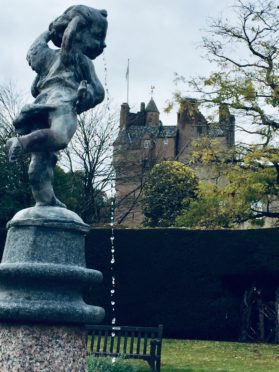A 19th-century water feature at Crathes Castle has been restored following a lengthy programme of conservation and repair work undertaken by the National Trust for Scotland.
Designed in the shape of a compass, the fountain and surrounding pond are a key feature in the property’s Fountain Gardens.
The water feature was originally installed in the 1880s and is a stand-out example of the region’s first uses of concrete to create structures.
Due to wear and tear over the past 100 years, however, the fountain fell into a state of disrepair and eventually ceased to work.
The lead putto statue on the fixture of a little boy holding a spouting fish was inspired by the work of Italian sculpture Palazzio Vecchio.
The restoration work which began in July this year was led by Scottish engineer John Addison who redesigned the fountain in its entirety, using a more eco-friendly and longer lasting concrete substitute called limecrete.
Generous donations from the conservation charity’s Patron’s Club members meant the old water pump could also be replaced, allowing water to flow at the fountain once again.
Iain Hawkins, general manager for National Trust for Scotland in the North East, said: “When we launched the project, the fountain was crumbling and eroded so by using new materials to recreate it, we found a modern fix for an old problem.
“The materials used mean that we can now ensure that the water feature remains a key part of Crathes’ beautiful gardens for future generations to enjoy.
“Protecting and conserving our heritage sites is a priority for the National Trust for Scotland regardless of how big or small the detail.
“Everything we do is for the love of Scotland, so we are extremely proud to see the fountain at Crathes working once again and looking as wonderful as it did 100 years ago.”
The fountain is fully operational for visitors to Crathes Castle to enjoy.
For more information on Trust properties in the North East of Scotland, visit www.nts.org.uk
